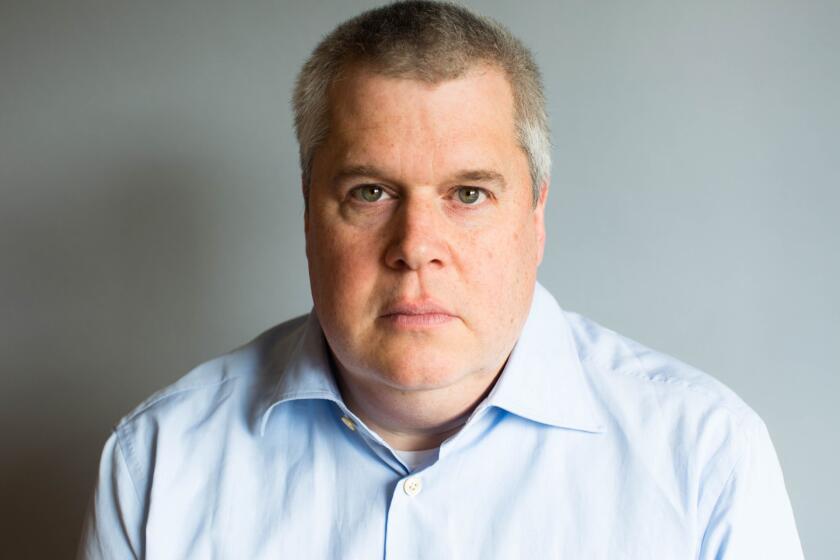
- Share via
Book Review
Q & A
By Adrian Tomine
Drawn and Quarterly: 168 pages, $16.95
If you buy books linked on our site, The Times may earn a commission from Bookshop.org, whose fees support independent bookstores.
I’ve long been attracted to books of instruction. I don’t mean self-help or craft manuals, but rather something more amorphous: prompts, ideas, inquiries, confessions. The “I Ching,” Brian Eno and Peter’s Schmidt’s “Oblique Strategies,” “The Paris Review Interviews” — I come to such efforts not because I believe they will offer answers but rather because they might help me to ask better questions. What I seek in them are approaches to process, a way to imagine or think about how to be more present and engaged.
“I often start with an idea or a character or a scene,” comics artist Adrian Tomine writes in “Q & A,” “and then just let it slosh around in my brain for a long time. … If I do this for long enough, I’ll eventually arrive at a rough version of the complete story in my mind.” Amen, brother, I would like to say.

“Q & A” represents both a book of instructions and something of a departure for Tomine, who for the last three decades has been among the most idiosyncratic and interesting comics creators around. Born in Sacramento, he began publishing his micro-comic “Optic Nerve” while still a teenager and has contributed to the New Yorker since 1999. His art is nuanced and self-reflected, marked by a vivid restlessness, moving from shorter to full-length works — among them the graphic narratives “Shortcomings” (2007) and “The Loneliness of the Long Distance Cartoonist” (2020) — that encompass the semi-autobiographical focus of many indie comics as well as a broader, read: fictional, lens.
“If someone were to read everything I’ve done,” Tomine told me during a 2015 interview for this newspaper, “they’d get a sense of how I’ve aged. Young people have limited experience. I had a mundane, happy childhood, without much struggle. My 20s were peaceful, privileged, but still I felt the desire to write angsty dramas. I couldn’t predict how things would change.”
Daniel Handler (aka Lemony Snicket) charts his process — as a writer, reader and for living life
‘And Then? And Then? What Else’ begins with a question — ‘What am I doing?’ — that leads to life lessons: Be curious. Accept nothing at face value. Opt for joy.
All of this — the angsty dramas and the more measured mature work, the recognition of art-making as a journey through time — sits at the center of “Q & A,” which is not comprised of images, for the most part, but text instead. Growing out of a Substack gig in which Tomine answered reader questions, the material here also has a deeper source: Letters he published in “Optic Nerve,” many of which he also answered privately, “usually with a handwritten postcard.” In that regard, it is as if he is looking through both ends of a telescope, collapsing the distance between the artist he has become and the one he once was.
Some of what he reveals is basic. His aim with “Q&A” “is to address the most common questions I’ve received over the years, and to do so with a greater level of attention than I’m usually able to provide while quickly scrolling through the messages on my phone.” We learn, for instance, how to pronounce his last name (“toe-mee-neh”), and the types of pens and paper he prefers. Yet even these relatively neutral questions yield some unexpected revelations, including his predilection for what he calls “cheap tools” — a reaction to the increasingly obsessive perfectionism he began to experience while completing “Shortcomings.”
Adrian Tomine’s eighth book, “Killing and Dying” (Drawn and Quarterly: 128 pp., $22.95), is his most intentional — or perhaps, it’s more accurate to say it grew out of specific imperatives.
“When I finally finished that book,” he acknowledges, “I made a decision to set aside most of my fancy art supplies and start from scratch, gravitating towards the cheapest, most readily available materials.”
The process Tomine is describing unfolds on micro and macro terms. There is how stories happen, and then the larger arc that animates a career. His 2015 collection “Killing and Dying” — which followed “Shortcomings” — marked not only a return to simpler tools but also a shift in perspective, in point of view. Before that, he divulges, “I had largely stuck to the old edict of ‘write what you know.’ … My challenge to myself with ‘Killing and Dying’ was to create characters and stories that were outside of my own direct experience, to allow each story to have its own distinct tone.”
On the one hand, “Q & A” is something of a how-to book. Certainly, I’ll be sharing it with students to illustrate what it takes to be an artist for the long haul, the self-interrogation required. But even more, I read it as, if not quite a memoir, then as a sequence of sketches that together add up to an impressionistic self-portrait in its own right.
Two new books, ‘Paris in Ruins’ and ‘Monet: The Restless Vision,’ capture the energy of a movement that reinterpreted history and presaged modern art.
As in his graphic work, Tomine is self-deprecating and often very funny. When he responds to a question about whether he’s ever had a real job, he reveals that his youngest daughter “recently went on an early morning tirade about how she has to get dressed and go to school every day, while I get to ‘stay home, draw, and eat soup in front of the TV. ’” (This same daughter is later quoted telling her grade school class, “My mom is a doctor who helps people with their feelings, and my dad sits at home and draws pictures of himself.”)
The dynamic reminds me of a story, perhaps apocryphal, about novelist and short story master John Cheever, who, it is said, ate breakfast with his children in a suit and tie every morning before taking the elevator downstairs to the basement of his apartment building, where he had fitted out a storage room as a makeshift office; he would hang up the suit and type all day in his underwear before getting dressed again and going upstairs at 5 o’clock.
In ‘Monica,’ comics icon Daniel Clowes (‘Ghostworld’ et al.) brings out his magnum opus — tonally varied, sensitive and, as he explains, deeply personal.
I like that anecdote because it humanizes Cheever, rendering him as father in addition to artist, framing his creativity in a larger context. Tomine does something similar with “Q & A.” Indeed, the back cover photograph shows the author stretched out on a couch surrounded by stuffed animals (and one live cat) beneath an array of children’s drawings.
Of the influence of parenthood, he observes: “As I type this, … one of my kids has a bad ear infection and the other one, due to various holidays and closures, only has nine full days of school this month. … It was something I resisted for a long time, but the truth is I currently feel more like a dad than anything else.” Still, he concludes, “as someone who has spent much of his life lonely, self-involved, and work-obsessed, I consider it a kind of success.”
Again, I am compelled to say: Amen.
Such a synthesis, art and life intertwined, has occupied the center of Tomine’s work all along. From “Optic Nerve” through “The Loneliness of the Long Distance Cartoonist,” he has drawn and written about the small things, the quotidian interactions, the way he and his characters must make it up as they go. That this is the case for every one of us hardly bears repeating, except, of course, it does.
The serendipity extends to the decisions we make, even when we don’t know we are making them. “[E]verything that I love about my present life,” Tomine notes, succinctly and directly, “can be traced back to the decision I made to start putting my teenage scribbles out into the world.”
There it is, once more, another instruction — not to tell us what we don’t know, but to remind us of what we do.
David L. Ulin is a contributing writer to Opinion. He is the former book editor and book critic of The Times.
More to Read
A cure for the common opinion
Get thought-provoking perspectives with our weekly newsletter.
You may occasionally receive promotional content from the Los Angeles Times.














